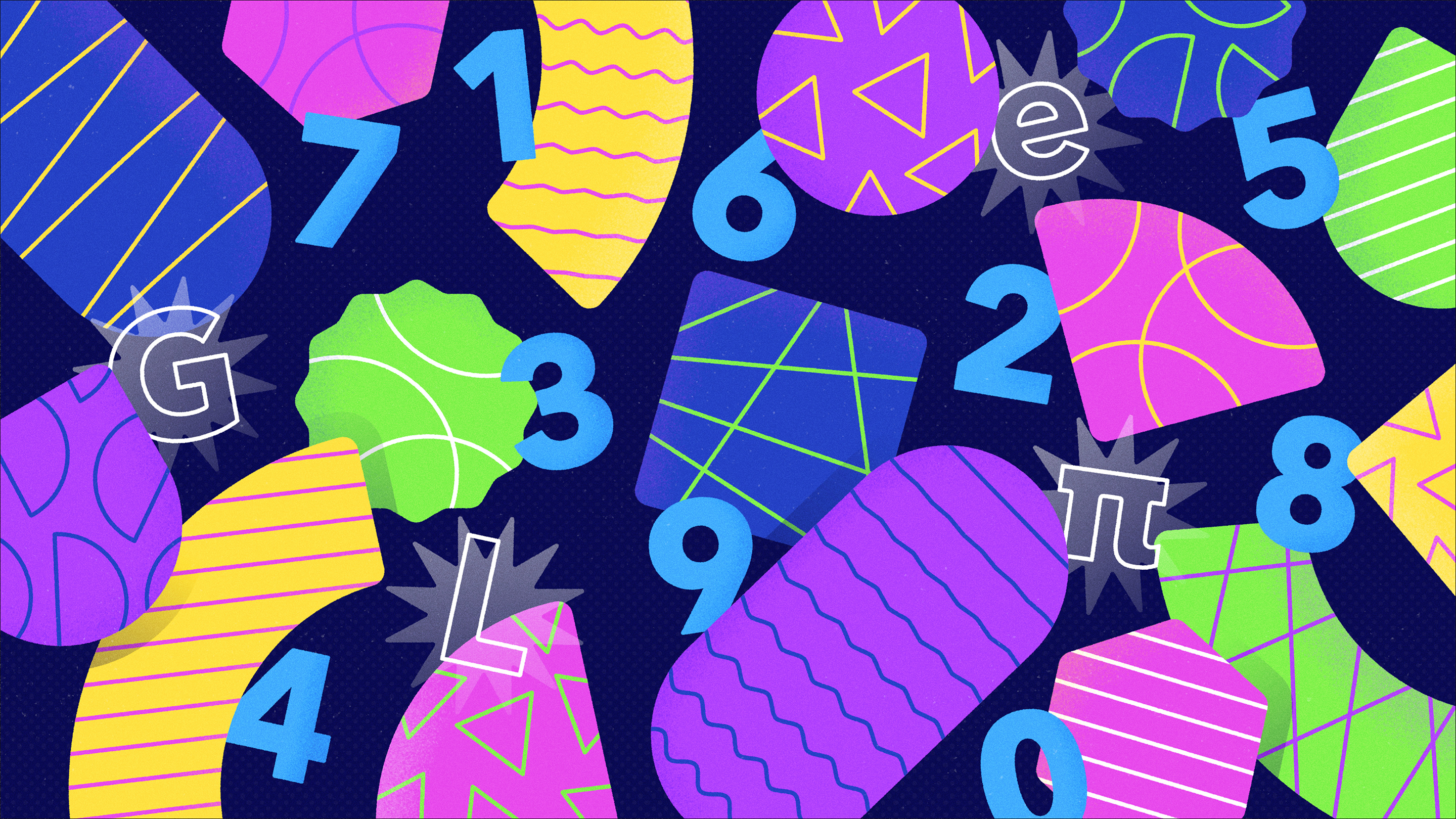Where Transcendental Numbers Hide in Everyday Math

James Round for Quanta Magazine
Introduction
In everyday language, the word “transcendental” connotes something that’s beyond the ordinary, something that is hidden and mysterious, with almost magical or mystical powers. In mathematics, on the other hand, the meaning of the term “transcendental” is more mundane. It simply describes the class of the infinitely many numbers that cannot be solutions of polynomial equations like ax3 + bx2 + cx + d = 0, where the coefficients a, b, c, etc., are all rational and the highest power of x can be any positive integer. As the great mathematician Leonhard Euler put it, “They transcend the power of algebraic methods.”
However, the everyday connotations of the word “transcendental” ring true for the two most famous transcendental numbers — the universal constants π and e. These two numbers are indeed mysterious and powerful and exhibit an almost magical quality. They play a central role in many branches of mathematics, popping out of nowhere in the solutions of problems when you least expect them. Of these two powerful constants, π is much more familiar to most of us. Every student knows its approximate value and has used it in calculations. But the other one, Euler’s number e or 2.71828…, is not as well known to most of us. But in fact, e was the first non-constructed number to be proved transcendental, by Charles Hermite in 1873. We have to specify “non-constructed” because in 1850, Joseph Liouville provided the first example of a provably transcendental number — but it was a number he constructed for that sole purpose, and it did not arise naturally in any branch of mathematics. This, of course, makes it quite different from e, which arises naturally almost everywhere in mathematics. Many of us know that e is the base of natural logarithms and arises in the theory of compound interest and exponential growth and decay, but we can do computations in these fields without explicitly encountering e. Today we will examine some ordinary-looking problems in which e shows up unexpectedly, giving us a fleeting glimpse of its universality.
Like π and other transcendental numbers, e has an infinite decimal representation — its digits go on forever without any discernible pattern. Nevertheless, the first 15 digits of e have a pattern that is pleasingly regular and easy to remember using the following digit grouping: 2.7 1828 1828 45 90 45. This regularity is, of course, a coincidence — the rest of the digits, as expected, are completely random. But e has several amazing properties that make it unique among all numbers. You will be introduced to some of these properties in this suite of puzzles, some of which are classical but, of course, with some additions of my own. The number e arises naturally in all of them, but they can be enjoyed even if you understand the reason for e’s appearance only vaguely. The exact details of this transcendental visitation can be left to those with the requisite mathematical training. Let’s see who can express this connection in the simplest possible way.
Puzzle 1: Partition
Let’s take any number, such as 10. Divide it into some number of identical pieces, such as two 5s, and multiply them together: 5 × 5 = 25. Now, we could have divided 10 into three, four, five or six identical pieces and done the same. Here’s what happens to our product when we do so:
2 pieces: 5 × 5 = 25
3 pieces: 3.33 × 3.33 × 3.33 = 37.04
4 pieces: 2.5 × 2.5 × 2.5 × 2.5 = 39.06
5 pieces: 2 × 2 × 2 × 2 × 2 = 32
6 pieces: 1.67 × 1.67 × 1.67 × 1.67 × 1.67 × 1.67 = 21.43
You can see that the product increases, reaches what seems to be a maximum and then starts decreasing. Try doing the same with some other numbers such as 20 and 30. You’ll notice that the same thing happens in every case. This has nothing to do with the numbers themselves but is caused by a unique property of the number e.
a. See if you can figure out when the product reaches a maximum for a given number and what this has to do with e. If you’re stumped, click on the hint below.
Hint:
b. For the number 10, the largest product (39.06) is about 5.5% larger than the next largest (37.04). Without calculating the actual difference, can you guess which number less than 100 has the smallest percentage difference between the largest product and the next largest? Why should this be?
c. Can you explain why e arises in this apparently simple problem?
Puzzle 2: Union
The unmarried heir to a billionaire’s fortune is in a bind. According to the terms of his inheritance, he needs to be married within 21 weeks or else he will forfeit his share. Despite the short deadline, he is determined to choose the best possible partner, so he signs up for a matrimonial app called e-marriage, which has the following rules. The app’s proprietary algorithms will match you with a highly compatible potential life-partner right away, and then every two weeks thereafter. In those two weeks, you must meet the candidate, get to know them, and either accept or reject them. Once candidates are rejected, they cannot be recalled.
The heir reasons that he can meet 10 already well-matched prospective candidates in 20 weeks and get married in the last week before the deadline. But he still wants to maximize his chances of choosing the best partner. So as he gets to know the candidates, he assigns a rank to each one. The problem is, he cannot predict the rankings of the candidates he hasn’t met or the final rankings for the candidates he has. If he accepts a candidate too early, he could miss out on a potentially better one. If he waits too long, he may have already rejected the best one.
a. How can the heir maximize his chances of choosing the best candidate, assuming there are no ties?
b. How do the heir’s chances change if there is a 10% chance of a tie for first place?
c. This problem is a classical one whose solution has something to do with e. Can you explain how e enters the picture?
While the classical problem does indeed focus on maximizing the heir’s chances of choosing the best life partner, not even e can guarantee transcendental bliss. That’s because, if the best candidate appears early and has been rejected, the heir may be stuck with a significantly lower-ranked candidate at the end of the 20th week. A more practical method is required if the goal is to pick one of the best candidates, but not necessarily the very best one. If we assume that the 10 candidates are ranked from 1 to 10, with 1 as the highest rank, we would like a way to pick, say, one of the top three or four most of the time.
d. How can the heir achieve the highest expected rank of his chosen candidate in this more practical choosing scenario?
Finally, for those who just cannot get enough of these e-puzzles, here’s a last, tougher one.
Puzzle 3: Togetherness
Let us suppose that the heir’s mission was successful and that he did find marital bliss and inherited his large fortune as well. The happy couple decide to celebrate with a getaway to a couples-only resort, where an exclusive concert has been scheduled in a large auditorium. The entry is on a first-come, first-served basis, and the audience consists of couples only, of course. When a couple enters the auditorium, they pick at random a pair of seats next to each other. Each new couple does the same, and in many cases this results in empty single seats between couples. The seating continues until only single seats are left. Then the auditorium is declared full, and the show starts.
a. What proportion of seats are expected to be left unfilled when the seating is stopped?
b. How does e enter this theater of togetherness?
That’s it for our transcendental suite. I hope you enjoy solving these puzzles and perhaps learn something about the amazing number e that you didn’t know before.
So, happy puzzling, and here’s wishing you e-harmony in your transcendental meditations.
Editor’s note: The reader who submits the most interesting, creative or insightful solution (as judged by the columnist) in the comments section will receive a Quanta Magazine T-shirt or one of the two Quanta books, Alice and Bob Meet the Wall of Fire or The Prime Number Conspiracy (winner’s choice). And if you’d like to suggest a favorite puzzle for a future Insights column, submit it as a comment below, clearly marked “NEW PUZZLE SUGGESTION.” (It will not appear online, so solutions to the puzzle above should be submitted separately.) Update: The solution has been published here.



